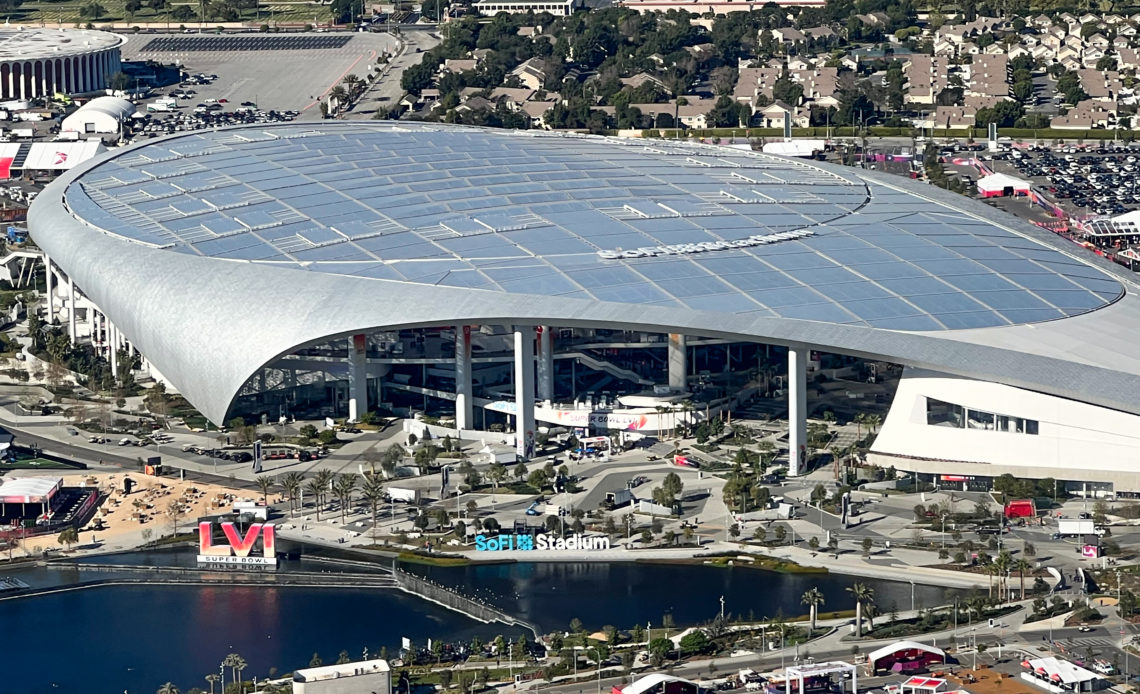
Sports stadiums had to change their game when the in-person experience of watching sports lost its allure as compelling digital alternatives captivated the audience. Super Bowl 2022, at the SoFi stadium in Los Angeles, was an inflection point for stadiums attempting to regain their audience. Super Bowl 2023 learned from the experience to augment it further.
The three major US carriers bet their 5G resources on Super Bowl 2022. They threw their entire portfolio of spectrum at it – low-band through mid-band to high-band millimeter wave. However, the network operators were not expecting more than 15 percent of the audience to use 5G due to the lack of compatible devices. Only the iPhone 11 and above could take advantage of 5G.
However, the SoFi stadium had a full house of 70,000 fans, and the audience touted it as a must-have experience. Data consumption rates reached new heights as 70% of the audience reached peak rates with Wi-Fi. Inevitably, Wi-Fi will soon reach its network capacity.
For the 2023 Super Bowl, the carriers increased the 4G and 5G densities with antennas installed underneath many seats. Throughput testing reached over 1 Gbps, far exceeding free Wi-Fi access.
SoFi: the dream sports stadium constructed with digital twins
Sports stadiums face a steep upward climb to match the experiences SoFi provided. The construction of the 3.1 million-square-foot stadium in Inglewood, California, began in November 2016. Digital Twins formed the foundation of SoFi for ease of construction. The digital twins have a lasting value throughout the lifecycle of the stadium as a source of data for maintenance to avoid unexpected breakdowns. Most of all, the visuals created by the digital twin will feed into the bonanza of meta-world experiences. Over time, private cellular networks are needed for processing the increasing volumes of data, high-speed visualization for application development, and simulation of operations scenarios to improve the experience for fans.
Digital twins are an abstracted virtual snapshot of the constructs of huge physical facilities that elude human comprehension. By resetting the digital virtual representation of gigantic physical objects, humans can intuitively grasp their contours with desired sizes, angles, and visual overlays. As a result, they are increasingly used to design, construct, and maintain massive facilities to increase productivity.
A digital twin is also the fulcrum for operations apparatus, security infrastructure, and the organization of shows and broadcasts. It provides a software overlay over several silos -the BMS (the Building Management Solution), HVAC, security, and access control that coalesce to deliver solutions for the stadium.
The expert and the interview
A discussion with one leadership team member involved in the design and construction of SoFi was instructive about the more significant issues of commercializing and monetizing innovative technologies like digital twins. Projects of this size and transformative potential don’t happen in one phase. Instead, they progress in each stage for budgetary reasons and to assess measurable benefits at each level.
“Such projects encounter formidable opposition from management and workers. However, we learned how the management team softened the resistance and skepticism to digital twin innovation by building confidence, demonstrating the financial ROI, and positioning them for articulated pain points that the users have already experienced,” the anonymous source explained.
The craftsmanship of digital twins
In its first phase, the digital twin development was an offline version that described the elements that form the overall project and their inter-relationships.
The digital twin subsumes all the paper and digital documentation, including shop drawings, paper forms, and digital assets such as dongles and drives. It includes over 1,800 3D models, represents over 145,000 assets, and over 80,000 live data points. The detail is helpful in operations when a quick check is needed to find out how a product failed, track warranties, and the maintenance schedules.
The angel is in the details
The threading of the details of projects and their representation of digital twins is a sound basis for proofs of concepts (POCs) for large projects. Currently, POC exercises look at an aspect of the project and compare it to another not affected. The conclusion is usually ambivalent as it does not account for the impact on the project with all its related components. By contrast, the digital twin captures all the interrelated effects based on the data from POCs. It measures and evaluates the impacts in real-time to make decisions on course corrections.
Conclusions
Sports stadiums have turned a corner as new communications infrastructure is created with 5G to raise the bar for live experiences in person in stadiums. The allure of live experiences will grow as fans are able to interact with games using 5G-compatible devices. Digital twins prepare the way to manage the life cycle of building activities, from planning for construction to operations and finally to creating digital experiences. They start by creating a database of the project’s provenance that becomes the reference point for all the events during the project’s life. The initial designs provide the wherewithal to create meta-world experiences.
This is part one of a three-part series on private networks and sports.


